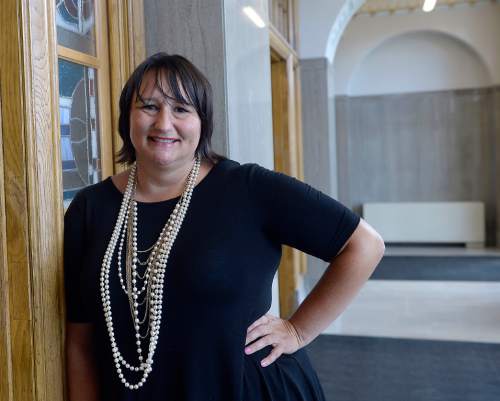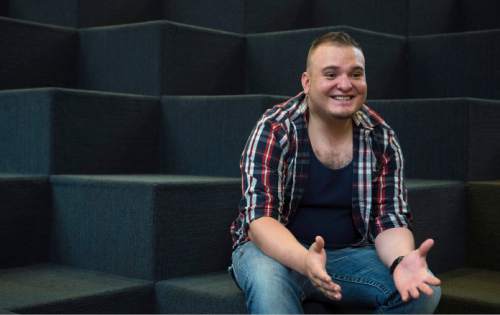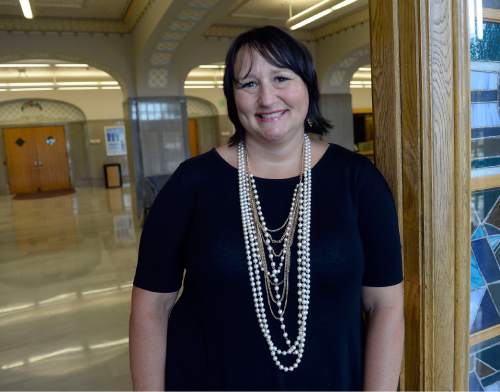This is an archived article that was published on sltrib.com in 2016, and information in the article may be outdated. It is provided only for personal research purposes and may not be reprinted.
Grantsville resident Loree Reece will spend part of her 40th birthday Aug. 4 taking final exams at Salt Lake Community College.
The mother of three decided to enroll at SLCC after she lost her bookkeeping and payroll job during company downsizing in January.
"I could potentially have time for a whole other career," she said.
Reece plans to go into the nursing field, saying it's a "safe bet" and also something she knows she's good at from past experience as a medical assistant.
But that means starting over from scratch roughly two decades after Reece attended a for-profit college, earning lingering debt and a transcript of nontransferable credits.
"I have 92 credits there and an associate degree and it's doing nothing for me," Reece said. "I just couldn't see the logic in doing more student loans."
Reece was eligible for a partial Pell grant, federal student aid that doesn't have to be repaid. And by receiving a Pell grant, Reece qualified for the SLCC Promise program, a new initiative that covers the gaps of other aid and allows students to attend college for free.
"Now is my time," Reece said. "Without this Promise program, I wouldn't be here."
Administrators at SLCC announced the Promise program in March, and so far roughly 300 students are benefiting from a combined $300,000 in waived tuition costs.
Eric Weber, SLCC's assistant vice president over student enrollment, said the pool of participants continues to grow and could reach 1,400 students at a combined cost between $1 million and $1.4 million during its first year.
Participating students must be Utah residents, commit to a full-time class schedule, maintain at least a 2.0 GPA and lock in a degree plan with an academic adviser, Weber said.
In exchange, Promise recipients don't have to worry about tuition, and their full-time schedule places them on track to graduate quickly, saving more time and money.
"If you make an investment in this way and it's predicated on people's success, it's money well-spent," Weber said.
Lisa Flinton, 39, was almost ready to throw in the towel on her education when she learned she qualified for the Promise program.
She wasn't sure how she could balance the time required to take classes with the need to work and cover her expenses.
Now those questions are gone, she said, and she can work part time while studying to become a radiology technician.
"It's gotten to the point in my life where I want to own a home," Flinton said. "I want the benefits of what an education can give me."
—
Filling in the gaps • SLCC's Promise program began taking shape last year, Weber said, after national leaders like President Barack Obama pushed the idea of free community college.
Now, he said, there are roughly 150 similar programs at colleges around the country.
"This is one of those things that seems to be catching on," he said.
The programs are also known as "last-dollar" initiatives, Weber said, in that they focus only on the tuition gaps that remain after existing student aid is exhausted, instead of offering full-ride scholarships.
That means one student might need $100 from the school, while another student receives $1,000.
"We want to get as many under the umbrella of having their tuition and general fees paid for," he said, "no matter what pays for them."
SLCC President Deneece Huftalin said the Promise program is designed to remove the barriers of time and cost that impede higher education.
Most students who enroll in school hope to earn a degree, she said, but program completion remains low.
"Our completion [rate] right now is 23 percent and we want to get it to 40 percent," Huftalin said. "The SLCC Promise is one of the levers we're creating to make that happen."
Boosting graduation rates is good for the school, she said. But it's also good for students who are able to go on to earn bachelor's and master's degrees or who elect to enter the workforce.
A key factor in the Promise program's design is encouraging students to complete the FAFSA, or Free Application for Federal Student Aid.
Utahns are among the nation's worst for FAFSA completion, with a recent report by NerdWallet estimating that only 34 percent of high school graduates submitted the financial aid form in 2014.
That low rate translated to $45.5 million in Pell grants being unclaimed by Utahns, NerdWallet estimated.
"We know that we are leaving a lot of money on the table that could be helping students go to college," said David Buhler, Utah's commissioner of higher education.
At SLCC, the school repurposed a number of merit-based tuition waiver programs to fund the Promise program.
The funds for those programs, combined with private donations, give the school a pool of resources to distribute as more students complete their FAFSA and receive Pell money.
"You don't even have to apply for Promise," Weber said. "You just have to apply using the Free Application for Federal Student Aid and if you have a gap, we give it to you."
Since 2010, Weber State University has offered a similar program, known as Dream Weber, which offers up to eight semesters free for participants.
To qualify, a student must be a Pell recipient and have an annual household income of $40,000 or less, said Brad Mortensen, the school's vice president for university advancement.
Free tuition, plus a full-time course schedule, resulted in a degree completion rate of 59.8 percent for the program's first cohort, Mortensen said, compared with 38.9 percent among the student body overall.
"The incentive of having that [tuition] burden removed for eight semesters really does seem to be working," Mortensen said.
Dream Weber had 2,476 participants last year, Mortensen said, including 1,892 whose Pell grants fully covered their tuition costs and 584 who received awards from WSU to cover tuition gaps.
That coverage combined for roughly $1 million in waived tuition, or an average award of $1,700 per student.
"We're very proud of what it's done at Weber State and the success it's had at making college not only affordable, but more attainable in the minds of students," Mortensen said.
—
Free for all • Covering 300 students at Salt Lake Community College and 584 students at Weber State University, the programs are far from the promise of free college for all.
Representatives from both schools said the low FAFSA completion makes it difficult to estimate the cost of a universal program.
But under the right circumstances, SLCC's Weber said, a guarantee of two years of free college to every full-time student is not unreasonable.
Student aid is a complicated national network of overlapping and potentially redundant programs, he said, which requires administration by school staff.
Mortensen said existing funds could be used more efficiently, helping a larger pool of student recipients.
"If you simplified it and you directed it to these kinds of [promise] initiatives," he said, "you probably wouldn't be spending much more, if any more, money than what is being spent now."
SLCC student Spencer Escobar, 27, plans to transfer to the University of Utah in two years and eventually attend medical school.
He said the Promise program provides some relief, mitigating the financial pressures of student life.
"A lot of the time when you're a student, you don't really know how you're going to pay for things," Escobar said. "You always wonder when you're going to be able to cover that next bill."
Buhler said he fully supports the Promise program, and that the Board of Regents, which oversees Utah's public colleges, is interested in what's happening at SLCC and Weber State.
Both schools developed their programs independently, with their student communities in mind, Buhler said. And it's likely that Utah's other public colleges and universities could follow suit.
"They're always watching each other and learning from each other," Buhler said. "I would not be surprised at all if other institutions picked this up and did something similar."
Twitter: @bjaminwood







